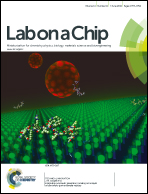A novel microfluidic approach for preparing chitosan–silica core–shell hybrid microspheres with controlled structures and their catalytic performance†
Abstract
A facile microfluidic approach to prepare chitosan–silica core–shell hybrid microspheres with different pore structures has been developed. The hybrid microspheres showed good performance in mechanics and adsorption and are outstanding and green catalyst supports. Under optimum conditions, the adsorption capacity of Cu(II) is about 1.7 times that of chitosan–silica hybrid microspheres with uniform component distribution for the effective protection of –NH2 provided by the silica shell while the mechanical intensity is about 2 times that of porous chitosan microspheres. Furthermore, when the adsorbed Cu(II) is reduced to Cu(I), the chitosan–silica supported Cu(I) will be an outstanding catalyst for azide–alkyne cycloaddition reaction and the reaction can complete in water within 3 h at room temperature. The catalyst was easy to be recovered just through sedimentation by gravity or filtration. Further, the chitosan–silica supported catalyst can be reused many times without losing its activity and it can be reproducible when the catalytic activity decreases. The whole process is green, environmentally friendly and atom economic.


 Please wait while we load your content...
Please wait while we load your content...